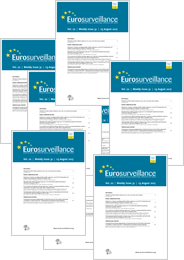- Home
- Weekly releases (1997–2007)
- Previous Issues
- Volume 6, Issue 43, 24/Oct/2002
Weekly releases (1997–2007) - Volume 6, Issue 43, 24 October 2002
Volume 6, Issue 43, 2002
- Articles
-
-
-
New programme of Community action in the field of public health (2003-2008)
More LessWith its publication on 9 October, the decision on the EU's new programme of Community action in the field of public health has entered into force (1). A major part of the programme concerns communicable diseases, and there is a particular commitment to strengthen international rapid response capacity. The decision sets out the aims for the programme, describes the actions and support measures, and creates the conditions for the European Commission to develop structural arrangements, such as a technical coordination centre (2), to ensure the effectiveness and the cohesion of measures and actions.
-
-
-
United States smallpox response plans: a commentary from the Bioterrorism Taskforce (BICHAT) perspective
J Hendriks , A Tegnell , P Bossi , A Baka , F van Loock , S Wallyn , L Vittozzi , B Lustig , H Maidhof , A Werner and G GouvrasMore LessThe US plan As the United States (US) continues to expand counterterrorism capabilities, smallpox has emerged as perhaps the most feared biological weapon because it is so contagious and deadly. With the possibility of a war with Iraq, the US Defense Department has asked for enough vaccine from the national smallpox vaccine stockpile for 1 million military personnel, to be available by the beginning of November 2002. To protect US citizens against a deliberate release of the smallpox virus, US federal experts have been working on a comprehensive preparedness plan with two tracks: a (pre-event) vaccination programme for the emergency medical workers most likely to see an initial case of smallpox, and a (post- event) mass vaccination plan if an attack occurs. The latter is now available and has recently been distributed to all states by the Centers for Disease Control and Prevention (CDC) (http://www.bt.cdc.gov/agent/smallpox/response-plan/index.asp). The documentation provided includes many detailed instructions and recommendations on the logistics that go with such a massive campaign. Of particular interest are the forms included for obtaining consent from people about to be vaccinated - a crucial issue. The manual states that following a confirmed smallpox outbreak in the US, rapid voluntary vaccination of a large population may be required.
-
-
-
First case of variant Creutzfeldt-Jakob disease reported in a United States resident
More LessLast week, the first case of probable variant Creutzfeldt-Jakob disease (vCJD) in a United States (US) resident was documented in the Morbidity and Mortality Weekly Report (1). The patient, a 22 year old woman living in Florida, first developed neuropsychiatric symptoms in November 2001, and was initially reported in April 2002 (2).
-
-
-
Group C meningococcus vaccination in the southwest region of France
More LessBetween 1995 and 2000, the incidence of confirmed serogroup C invasive meningococcal infection (IMIC) in France, adjusted for undernotification, increased from 0.14 to 0.24 cases per 100 000 inhabitants. In 2001, the rate reached 0.40/100 000, which was attributable to an increase in the incidence of all invasive meningococcal infections (IMI), and also to the fact that the proportion of IMIC increased from 23% to 35% of all IMI(1).
-
-
-
Outbreak of Salmonella Enteritidis PT 14b in the United Kingdom – second update
More LessThe cumulative total of cases of gastroenteritis infected with the outbreak strain of Salmonella Enteritidis PT 14b (not known to be linked with foreign travel) reported to the Public Health Laboratory Service Communicable Disease Surveillance Centre in England (PHLS CDSC) by the Laboratory of Enteric Pathogens (LEP) since 26 September is now 224 (1). All the outbreak related strains examined so far have similar plasmid profile and pulsed field gel electrophoresis patterns. The dates of onset for confirmed cases reported since 26 September, where available, range from 3 September to 13 October 2002 (figure) and the epidemic curve is consistent with continuing exposure to a source of infection. There have been two deaths.
-
-
-
Nosocomial outbreak of Salmonella Enteritidis PT 6a (Nx, CpL) in the United Kingdom
More LessDuring an ongoing investigation into a nosocomial outbreak of S. Enteritidis PT 6a (Nx, CpL) in London, where raw shell eggs were being used, the London Food, Water and Environmental Microbiology Laboratory (LFWE) tested 402 raw shell eggs obtained from the premises. Two hundred and forty of these were labelled as imported, and four of the 40 samples of six pooled whole eggs were positive. The Laboratory of Enteric Pathogens (LEP) at the Public Health Laboratory Service Communicable Disease Surveillance Centre (PHLS CDSC) confirmed the presence of S. Enteritidis PT 6 (one sample), S. Enteritidis PT 13a (one sample) and S. Enteritidis PT 14b (one sample). Of the 27 samples from the unlabelled eggs (162 eggs) one sample was positive for S. Enteritidis PT 6. Results are awaited on the final isolate. Since the raw eggs have been withdrawn from use no further cases have occurred. Hospitals in the United Kingdom are reminded that advice issued by the Chief Medical Officer in 1988 that raw shell eggs should be replaced with pasteurised eggs in recipes in institutions with high risk groups (1) is extant and must be adhered to if vulnerable patients are not to be put at risk.
-
-
Most Read This Month

-
-
Chikungunya in north-eastern Italy: a summing up of the outbreak
R Angelini , A C Finarelli , P Angelini , C Po , K Petropulacos , G Silvi , P Macini , C Fortuna , G Venturi , F Magurano , C Fiorentini , A Marchi , E Benedetti , P Bucci , S Boros , R Romi , G Majori , M G Ciufolini , L Nicoletti , G Rezza and A Cassone
-
- More Less


